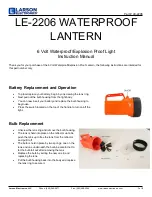
8.3 Routine Examination
During maintenance, the parts affecting the level of
protection must be checked in particular:
- Ensure the lamp is lit when energised and examine
the enclosure and glass for any signs of cracks and
damage.
- When de-energised and left to cool, there should be
no significant sign of internal moisture. If there are
signs of water ingress, the luminaire should be opened
up, dried out, and any likely ingress points eliminated
by re-gasketing, re-greasing or other replacement.
- Check the gasket of terminal chamber gasket and LED
housing for any damage or permanent set and replace
as required.
- Terminal, screw glands and blanking plugs for secure
fitting.
- To maintain the light output, clean the protective
glass periodically with a damp cloth or a mild cleaning
fluid.
- If this product is used in the dust area, outside of
enclosure must be cleaned on a regular basis to
prevent accumulation of dust.
- The terminal chamber should be opened periodically
and checked for moisture and dirt ingress. The cable
connections should be checked for tightness. The
gasket should be checked for cracks or lack of elasticity,
and if necessary, replaced. Cover bolt torque: 1.5Nm.
- Check that mountings are secure and the adjusting
bolts are tight.
- If it has been suspected that the luminaire has
mechanical damage, a stringent workshop overhaul will
be required. Where spares are needed, these must be
replaced with factory specified parts.
No modifications should be made without the
knowledge and approval of the manufacturer.
9. Repair/Overhaul/Modifications
9.1 General
The national regulations have to be observed! Repairs
and overhaul may only be carried out with genuine
Cooper Crouse-Hinds spare parts.
Before replacing or disassembling individual parts,
observe the following:
Disconnect the power supply to the equipment before
maintenance/repair.
See section 5.4 for notes on opening and closing the
lamp.
Only use original spare parts. If the luminaire was
previously in operation then wait to cool enough
before opening. Modifications to the device or
changes to its design are not permitted.
Assistance may also be obtained through Cooper
Electronic Technologies (Shanghai) Co., Ltd. Sales
Service department,
955 ShengLi Road, Pudong Shanghai 201201
Phone (86) 21-28993943
10. Disposal/Recycling
When the apparatus is disposed of, the respective
national regulations on waste disposal will have to be
observed.
Use proper supply wiring as specified on the
nameplate of the luminaire and in this instructions!
Excessive tightening may affect or damage the
connection.
5.5.1 Wire connection
The conductors shall be connected with special care.
The conductor itself shall not be damaged.
The connectible min. and max. conductor cross-
sections shall be observed (see technical data). All
terminals, used and unused, shall be fully tightened
to prevent incorrect selection 2.5Nm for Pillar
terminals. Main connection: See wiring diagram.
Note: Set one switch at L1 outside of the lighting,
when switch off power, but still charge battery at
daytime; The charging conductor L1 and the
luminaire’s mains connection must always be
connected to the same external conductor of the
mains supply! if the Emergency luminaire and
Normal luminaire use one same supply source,
refer to Fig 5.
See Fig.2, Fig.3 Fig.4 and Fig.5 for details.
6. Putting into operation
Prior to putting the apparatus into operation, the
tests specified in the relevant national regulations
shall be carried out. Insulation measurements may
only be carried out between PE and the external
conductor L1 (L2, L3) as well as between PE and N.
- Measurement voltage: Max. 1 KV AC/DC
- Measurement current: Max.10 mA
- The luminaire may only be operated when closed.
IM0284.Revision 5 05/17
Page 2 of 2
Prepare the conductor as the
drawing before connect it to
the earth screw.
Fig.2 Electrical connection
Vertical adjustment only at the
desired angle(-90
°
to +60
°
)
Fig.1 Permissible angle of adjustment
Fig.4 Wiring diagram
(EM version)
7. Type configuration
Std. Cat No.
System
power
Voltage
PLE-3L*****
28W
AC:
100-240V
50/60Hz;
DC: 108~250V
PLE-5L*****
PLE-4L**-F**
PLE-4L**-W**
PLE-3L**-W-F**
35W
PLE-6L*****
PLE-5L**-F**
PLE-5L**-W**
PLE-4L**-W-F**
51W
PLE-7L*****
PLE-6L**-F**
63W
PLE-8L*****
PLE-7L**-F**
PLE-6L**-W**
PLE-5L**-W-F**
75W
PLE-3L****-EM*
PLE-4L****-EM*
PLE-5L****-EM*
Note:
EM1—1.5H, 30% output;
EM2—3H, 15% output;
46W
8. Maintenance/Servicing
8.1 General
The relevant national regulations which apply to the
maintenance/servicing of electrical apparatus shall
be observed. The interval between maintenance
depends upon the ambient conditions and the
hours of operation.
8.2 Checks
The equipment must be de-energised before
opening
Visual inspection should be carried out at a
minimum of 12 monthly intervals and more
frequently if conditions are severe. The time
between lamp changes could be very infrequent
and this is too long a period without inspection.
For version with cable
Brown: L
Blue: N
Black: L1
Yellow/Green: Ground
For version with cable
Brown: L
Blue: N
Yellow/Green: Ground
Fig.5 Wiring diagram
Fig.3 Wiring diagram(Normal version)





















